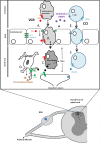Changes in blood-spinal cord barrier permeability and neuroimmune interactions in the underlying mechanisms of chronic pain
- PMID: 33981925
- PMCID: PMC8108584
- DOI: 10.1097/PR9.0000000000000879
Changes in blood-spinal cord barrier permeability and neuroimmune interactions in the underlying mechanisms of chronic pain
Abstract
Advancing our understanding of the underlying mechanisms of chronic pain is instrumental to the identification of new potential therapeutic targets. Neuroimmune communication throughout the pain pathway is of crucial mechanistic importance and has been a major focus of preclinical chronic pain research over the last 2 decades. In the spinal cord, not only do dorsal horn neurons partake in mechanistically important bidirectional communication with resident immune cells such as microglia, but in some cases, they can also partake in bidirectional crosstalk with immune cells, such as monocytes/macrophages, which have infiltrated into the spinal cord from the circulation. The infiltration of immune cells into the spinal cord can be partly regulated by changes in permeability of the blood-spinal cord barrier (BSCB). Here, we discuss evidence for and against a mechanistic role for BSCB disruption and associated changes in neuroimmune crosstalk in preclinical chronic pain. We also consider recent evidence for its potential involvement in the vincristine model of chemotherapy-induced painful neuropathy. We conclude that current knowledge warrants further investigation to establish whether preventing BSCB disruption, or targeting the changes associated with this disruption, could be used for the development of novel approaches to treating chronic pain.
Keywords: Blood–spinal cord barrier; Chemotherapy-induced pain; Monocytes/macrophages; Neuroimmune interactions.
Copyright © 2021 The Author(s). Published by Wolters Kluwer Health, Inc. on behalf of The International Association for the Study of Pain.
Conflict of interest statement
The authors have no conflicts of interest to declare.Sponsorships or competing interests that may be relevant to content are disclosed at the end of this article.
Figures

Similar articles
-
C-X-C Motif Chemokine 10 Contributes to the Development of Neuropathic Pain by Increasing the Permeability of the Blood-Spinal Cord Barrier.Front Immunol. 2020 Mar 20;11:477. doi: 10.3389/fimmu.2020.00477. eCollection 2020. Front Immunol. 2020. PMID: 32265928 Free PMC article.
-
Role of the immune system in neuropathic pain.Scand J Pain. 2019 Dec 18;20(1):33-37. doi: 10.1515/sjpain-2019-0138. Scand J Pain. 2019. PMID: 31730538 Review.
-
Peripheral nerve injury alters blood-spinal cord barrier functional and molecular integrity through a selective inflammatory pathway.J Neurosci. 2011 Jul 27;31(30):10819-28. doi: 10.1523/JNEUROSCI.1642-11.2011. J Neurosci. 2011. PMID: 21795534 Free PMC article.
-
Role of the blood-spinal cord barrier: An adheren junction regulation mechanism that promotes chronic postsurgical pain.Biochem Biophys Res Commun. 2023 Jun 11;660:65-72. doi: 10.1016/j.bbrc.2023.04.021. Epub 2023 Apr 11. Biochem Biophys Res Commun. 2023. PMID: 37068390
-
Propitious Therapeutic Modulators to Prevent Blood-Spinal Cord Barrier Disruption in Spinal Cord Injury.Mol Neurobiol. 2017 Jul;54(5):3578-3590. doi: 10.1007/s12035-016-9910-6. Epub 2016 May 18. Mol Neurobiol. 2017. PMID: 27194298 Review.
Cited by
-
The Impact of P-Glycoprotein on Opioid Analgesics: What's the Real Meaning in Pain Management and Palliative Care?Int J Mol Sci. 2022 Nov 16;23(22):14125. doi: 10.3390/ijms232214125. Int J Mol Sci. 2022. PMID: 36430602 Free PMC article. Review.
-
Novel Strategies for Spinal Cord Regeneration.Int J Mol Sci. 2022 Apr 20;23(9):4552. doi: 10.3390/ijms23094552. Int J Mol Sci. 2022. PMID: 35562941 Free PMC article. Review.
-
Quantifying Vascular Remodeling in the Mouse Spinal Cord.Methods Mol Biol. 2022;2441:191-200. doi: 10.1007/978-1-0716-2059-5_15. Methods Mol Biol. 2022. PMID: 35099738
-
Dermorphin [D-Arg2, Lys4] (1-4) Amide Attenuates Burn Pain by Inhibiting TRPV1/NR2B Mediated Neuroinflammatory Signalling.Mol Neurobiol. 2025 May 29. doi: 10.1007/s12035-025-05068-0. Online ahead of print. Mol Neurobiol. 2025. PMID: 40442534
-
Versatile Role of Prokineticins and Prokineticin Receptors in Neuroinflammation.Biomedicines. 2021 Nov 9;9(11):1648. doi: 10.3390/biomedicines9111648. Biomedicines. 2021. PMID: 34829877 Free PMC article. Review.
References
-
- Abbott NJ, Patabendige AA, Dolman DE, Yusof SR, Begley DJ. Structure and function of the blood-brain barrier. Neurobiol Dis 2010;37:13–25. - PubMed
-
- Baron R, Binder A, Wasner G. Neuropathic pain: diagnosis, pathophysiological mechanisms, and treatment. Lancet Neurol 2010;9:807–19. - PubMed
-
- Bartanusz V, Jezova D, Alajajian B, Digicaylioglu M. The blood-spinal cord barrier: morphology and clinical implications. Ann Neurol 2011;70:194–206. - PubMed
Publication types
Grants and funding
LinkOut - more resources
Full Text Sources
Other Literature Sources
